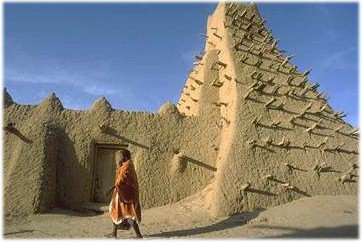The first great Sahelian kingdom was Ghana, but the Islamic revolution of the Almoravids, a Berber people living north of Ghana, splintered that kingdom. The Almoravids did not succeed in building their own, Islamic kingdom in the region. The Almoravid revolution, however, led to energetic Islamic proselytizing all throughout the Sahel. Many of the ruling families converted to Islam.
 One
of these ruling families, the Keita, forged the successor to the Ghanaian
kingdom, the kingdom of Mali. As with Ghana, Mali was built off of the
monopolization of the trade routes from western and southern Africa to eastern
and northern Africa. The most lucrative of these monopolies was the gold trade.
Mali was located farther south than Ghana; the Malians lived in an
agriculturally fertile land. Mali was also locate along the upper Niger river,
while Ghana had been located to the west. The bulk of the gold trade proceeded
up the Niger river, so this gave Mali a firmer grip on this lucrative monopoly.
Mali was not a true empire, but rather the center of a sphere of influence. The
territory controlled by Mali comprised three distinct regions: the Senegal
region with people speaking Niger-Kongo languages, the central Mande states
occupied by Soninke and Mandinke, and the region of Gao occupied by people who
spoke Songhay.
One
of these ruling families, the Keita, forged the successor to the Ghanaian
kingdom, the kingdom of Mali. As with Ghana, Mali was built off of the
monopolization of the trade routes from western and southern Africa to eastern
and northern Africa. The most lucrative of these monopolies was the gold trade.
Mali was located farther south than Ghana; the Malians lived in an
agriculturally fertile land. Mali was also locate along the upper Niger river,
while Ghana had been located to the west. The bulk of the gold trade proceeded
up the Niger river, so this gave Mali a firmer grip on this lucrative monopoly.
Mali was not a true empire, but rather the center of a sphere of influence. The
territory controlled by Mali comprised three distinct regions: the Senegal
region with people speaking Niger-Kongo languages, the central Mande states
occupied by Soninke and Mandinke, and the region of Gao occupied by people who
spoke Songhay. The historical founder of Mali was the magician, Sundjata, one of the most legendary figures in African history. Sundjata, who ruled Mali from 1230-1255, began as a royal slave and magician among the Soso who had inherited the Ghanaian empire. According to African oral histories, Sundjata seized the major territories through which gold was traded and so built the foundation off of which Mali would be built. He also introduced into the region the cultivation and weaving of cotton.

The most significant of the Mali kings was Mansa Musa (1312-1337) who expanded Mali influence over the large Niger city-states of Timbuctu, Gao, and Djenné. Mansa Musa was a devout Muslim who built magnificent mosques all throughout the Mali sphere of influence; his gold-laden pilgrimage to Mecca made him an historical figure even in European history writing.
It was under Mansa Musa that Timbuctu became one of the major cultural centers not only of Africa but of the entire world. Under Mansa Musa's patronage, vast libraries were built and madrasas (Islamic universities) were endowed; Timbuctu became a meeting-place of the finest poets, scholars, and artists of Africa and the Middle East. Even after the power of Mali declined, Timbuctu remained the major Islamic center of sub-Saharan Africa.
After the death of Mansa Musa, the power of Mali began to decline. Mali had never been an empire proper, and subject states began to break off from the Mali sphere of influence. In 1430, the Tuareg Berbers in the north seized much of Mali's territory, including the city of Timbuctu, and the Mossi kingdom to the south a decade later seized much of Mali's southern territories. Finally, the kingdom of Gao, which had been subjugated to Mali under Mansa Musa, gave rise to a Songhay kingdom that finally eclipsed the magnificent power of Mali. Mansa Musa